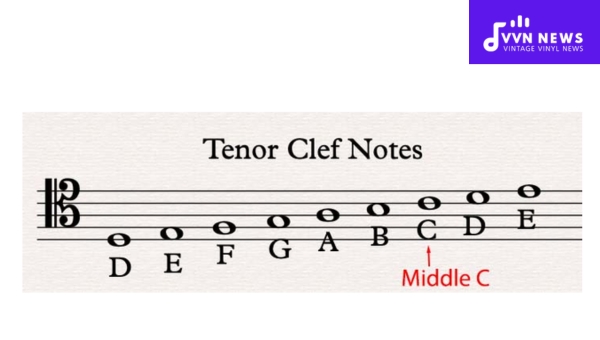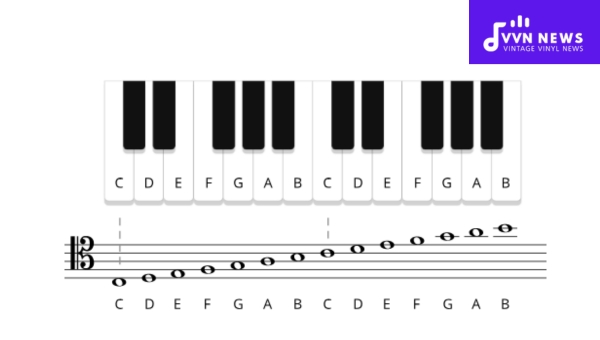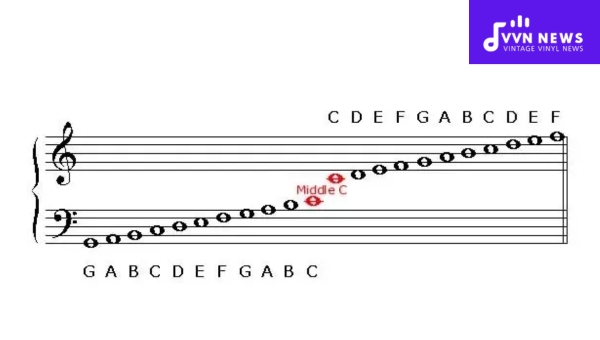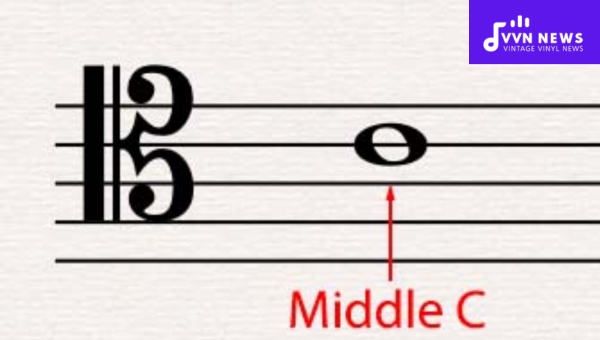As a music enthusiast, you may have often wondered about the variety of musical notations and symbols that create the melodic symphonies we enjoy.
Among these many symbols, a certain clef particularly stands out for its specialty and the role it plays in written music – the tenor clef. In the vast world of music, different systems of notation are used to cater to multiple instruments and vocal ranges.
Whether it’s for an orchestra’s melodious viola or an edgy trombone in a jazz band, tenor clef has its significant place.
Despite being quite essential, it might not be as commonly known as other elements, like the treble or bass clefs. Today, let’s embark on an exploration of what makes this particular notation unique and discerning.
What is the Tenor Clef?
The tenor clef is a type of C clef centered on the fourth line of the five-line staff. Its symbol, consisting of two curves embracing a vertical line, denotes that the central note (middle C) rests on this fourth line.

Unlike more popular clefs like treble or bass, it’s primarily utilized for upper-range instrumental parts, namely in cellos, trombones, and bassoons.
The tenor clef represents an interesting shift in tone from what we might be accustomed to with other music notation. This makes it an intriguing element to explore while delving deeper into music reading and interpretation.
Also Read: A Minor Scale [Unlock The Mysteries Of Musical Composition]
The Purpose of the Tenor Clef
The tenor clef is one of the many symbols or marks we can see in music sheets. Its purpose is quite distinctive and essential. Let me walk you through it.
Interestingly, the tenor clef isn’t as commonly utilized as the treble or bass clefs. It occupies a significant place in music notation when navigating certain ranges.
Its primary usage is on mid-level notes, specifically for instruments with lower ranges that sometimes need to play in higher registers. Many pieces of sheet music for instruments like the trombone, bassoon, viola, cello, and double bass make extensive use of this clef to avoid excessive ledger lines when notating higher pitches.
This makes reading music more manageable and convenient. Furthermore, the tenor clef also comes into play within vocal music writing for male voices—tenors, hence its nomenclature.
In essence, this unique sign enables fluidity in transcribing and interpreting musical notes while maintaining visual clarity on the score.
What notes are found on the Tenor clef’s staff?
It’s crucial to decode the notes on a tenor clef to decipher musical compositions accurately.

When placed on the staff, the tenor clef’s lineup encompasses seven distinct musical notes: D, E, F, G, A, B, and C. But let’s unfold their positioning more extensively:
- D is positioned below the staff line.
- E, you’ll find sitting alone on the lowest line.
- F lies in synchronization with the first space.
- Transitioning higher up, G strides upon the second line.
- Next off in line is A, nuzzled safely within the second space domain.
- Then we reach B, marking its territory on the middle line.
- Concluding this ensemble within the clef periphery is note C, comfortably occupying the fourth space.
Each of these notes collaboratively makes a significant contribution to the design of comprehensive and melodious symphonies around the globe.
Also Read: Harmony In Music [Enhance Your Compositions With These Tips]
How do you read music in Tenor clef?
To unfold the magic of tenor clef rhapsodies, let’s initiate our journey by reading music notated in this particular clef.
Suspended between the widely utilized treble and bass clefs, the tenor clef is a movable C-clef that dictates the exact position of the middle C on the staff. Here, the C resides on its fourth line.
When music is notated using the tenor clef, every line and space represents a different pitch or note, with its ascending or descending order depending almost entirely on movement up or down the staff.
The total absence of sharp or flat signs at the start merely signifies that the piece exists within C Major’s harmonious realms. Still, any accidental encounter with sharps and flats along your way defines your diversion into chromatic territory.
How can I practice reading notes on lines in Tenor clef?
To swiftly master tenor clef comprehension skills without repetitively emphasizing rote memorization strategies often found redundant within pedagogical contexts, I propose creating a mnemonic device—an acronym—to remember pitches assigned to each line.
A recommended mnemonic for these line notes – D, F, A, C, and E could be ‘Don’t Forget All Clefs Exist.’ This phrase not only ingrains in your mind the sequence of these pitches but also sheds light on their inherent connectivity and your musical framework as a whole.
Practice for reading space notes?
Practicing space notes gets much less complicated when you have another useful memory aid at your disposal.
Imaginative use of each note – E, G, B, D – forms sentences like ‘Every Good Band Dances,’ enabling quicker recollection while sight-reading scores punctuated with tricky spaces set within tenor clef confines.
With consistent practice, the diligent decoding of tenor clef’s enigmas will become second nature, enhancing your ability to appreciate the harmonious beauty emanating from this distinctive clef.
The gratification experienced when you decipher a melody without hesitation, indeed, amplifies your overall musical experience, akin to adding more colors to the vibrant spectrum of sound.
Also Read: F Sharp Minor Pentatonic Scale [How To Use In Your Compositions]
How to Draw a Tenor Clef Correctly?
Drawing a tenor clef can appear somewhat challenging at first, but with practice, it can become as natural as doodling in the margins of your notebook.

- Start with a vertical line. It’s best to start from the top and work your way down, this will be the backbone of your clef.
- Halfway up the line, create a half-oval shape curving to the right. This forms the main part of your clef.
- Repeat this half-oval slightly below the first one, smaller and tilted upwards.
- Draw two dots, one above and one below the second line from the top of your staff.
These steps will guide you to draw an accurate tenor clef sign. The dots should be placed precisely to indicate C on a staff sheet clearly, making it easier for musicians to read accurately.
What instruments are played using the Tenor clef?
There are several instruments for which music is often written in the tenor clef, each with its unique tone and personality:
- Bassoon This bass-range wind instrument produces a versatile tone providing both rhythmic support and lyrical solos. The tenor clef serves as an ideal medium to express the range of sounds the bassoon can produce, especially when performing intricate middle-to-high-range melodies.
- Cello When a cello’s melody ascends into its upper register, it transitions to the tenor clef. This notation allows cellists to read high pitches more easily without excessive ledger lines above the bass staff.
- Double Bass While primarily written in bass clef, music for the double bass transitions into tenor clef when tackling higher pitch ranges. It simplifies reading through saving space and reducing confusion over multiple ledger lines.
- Euphonium The euphonium primarily uses bass clef; however, tenor clef becomes crucial with more advanced literature when reaching above its comfort zone.
- Trombone Though much of trombone literature relies on bass clef notation, tenor clef’s utility surfaces during upper-register passages that might be otherwise challenging to read.
The specialty of tenor clef lies in its ability to facilitate ease of reading for these instruments when they venture into higher pitch ranges, making musical interpretation quicker and less cumbersome.
Also Read: How To Transpose Treble To Bass Clef [Music Guide]
FAQs
What symbol represents the tenor clef?
The tenor clef is represented by the symbol of a “C clef” centered on the fourth line of the staff.
Why is it called the ‘tenor’ clef?
It’s referred to as ‘tenor’ mainly because it is often used for music that falls within the tenor vocal range.
How does a musician know when to switch to tenor clef?
Typically, composers indicate the switch with a clef symbol at the exact point where musicians need to change their reading.
Besides viola and trombone, which other instruments use tenor clef?
Instruments like bassoon, euphonium, double bass, and cello also sometimes use the tenor clef.
Which line does middle C fall on in a Tenor Cleff?
Middle C falls on the fourth line up from the bottom in a Tenor Cleff.
Also Read: E Major Triad [Master This Staple Of Music Composition]
Conclusion
The tenor clef is more than just a symbol on a music sheet; it’s an essential tool for musicians to precisely bring notes to life. If you’re seeking to build your music reading skills, practice daily, and soon reading the tenor clef will become second nature to you.
May this guide serve as a foundational block in your journey of musical exploration and inspire an even deeper appreciation for the exquisite complexities found within the realm of music notation.








